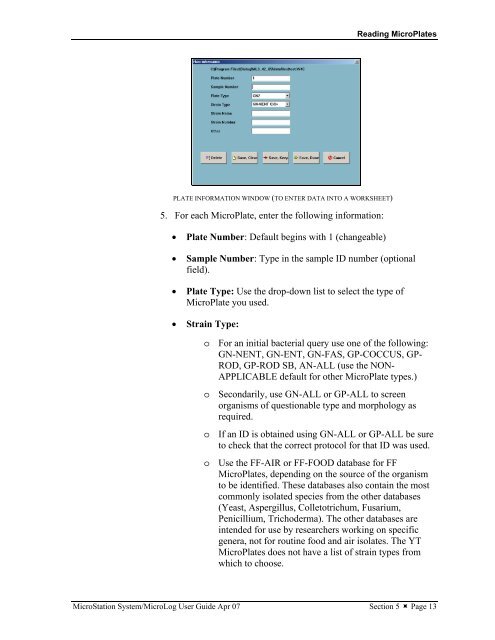MicroStation System, MicroLog Version 4.2 - DTU Systems Biology ...
MicroStation System, MicroLog Version 4.2 - DTU Systems Biology ...
MicroStation System, MicroLog Version 4.2 - DTU Systems Biology ...
Create successful ePaper yourself
Turn your PDF publications into a flip-book with our unique Google optimized e-Paper software.
PLATE INFORMATION WINDOW (TO ENTER DATA INTO A WORKSHEET)<br />
5. For each MicroPlate, enter the following information:<br />
• Plate Number: Default begins with 1 (changeable)<br />
Reading MicroPlates<br />
• Sample Number: Type in the sample ID number (optional<br />
field).<br />
• Plate Type: Use the drop-down list to select the type of<br />
MicroPlate you used.<br />
• Strain Type:<br />
o For an initial bacterial query use one of the following:<br />
GN-NENT, GN-ENT, GN-FAS, GP-COCCUS, GP-<br />
ROD, GP-ROD SB, AN-ALL (use the NON-<br />
APPLICABLE default for other MicroPlate types.)<br />
o Secondarily, use GN-ALL or GP-ALL to screen<br />
organisms of questionable type and morphology as<br />
required.<br />
o If an ID is obtained using GN-ALL or GP-ALL be sure<br />
to check that the correct protocol for that ID was used.<br />
o Use the FF-AIR or FF-FOOD database for FF<br />
MicroPlates, depending on the source of the organism<br />
to be identified. These databases also contain the most<br />
commonly isolated species from the other databases<br />
(Yeast, Aspergillus, Colletotrichum, Fusarium,<br />
Penicillium, Trichoderma). The other databases are<br />
intended for use by researchers working on specific<br />
genera, not for routine food and air isolates. The YT<br />
MicroPlates does not have a list of strain types from<br />
which to choose.<br />
<strong>MicroStation</strong> <strong>System</strong>/<strong>MicroLog</strong> User Guide Apr 07 Section 5 � Page 13


